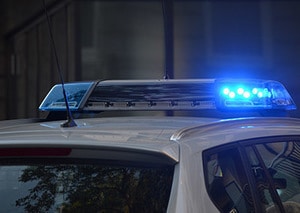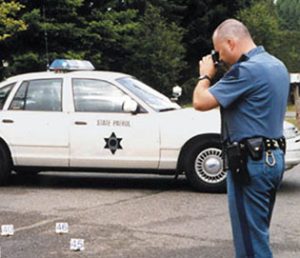What’s Involved in Crime Scene Photography?
Perhaps one of the most valuable applications of PhotoModeler Technologies’ photogrammetry software–which lets users measure areas from photographs–is in crime scene and forensic photography. Photogrammetry software is valuable to forensic photography because the images taken by crime scene photographers must often be used to present facts about conditions, distances, and placement to a court as evidence against a suspect.
- What Is Crime Scene Photography?
- Crime Scene Photo Process
- Photogrammetry in Crime Scene Photography
For those who don’t know, photogrammetry software–of the type offered by PhotoModeler Technologies–uses photographs of an object, scene, or area of land to create 2D or 3D models of the objects or landscapes depicted in those photos. We’ll explain a bit more about the process later, but you can also reference our “How Does Photogrammetry Work?” piece for a full detailing of photogrammetry itself.
Given that law enforcement officials may use photogrammetric models to solve crimes, the onus of taking revealing photos of clues at crime scenes, and even knowing what to photograph at all, is especially intense for forensic photographers. They must capture the right shots from all the right angles. Then, photogrammetry software will allow police to create 360-degree digital views of the scene the photographers shot. Therefore, photogrammetry software can be essential to law enforcement and public safety.
In this post, you can read about what crime scene photography involves and how PhotoModeler’s photogrammetry software can help police to document crime scenes accurately enough to figure out what happened.
What Is Crime Scene Photography?
We’ll start with a discussion of crime scene photography itself. Photography is an unequivocally crucial element of any criminal investigation. The photos taken at a crime scene document every aspect of the area before police begin cleaning up what will possibly become key pieces of evidence in a prosecution.
For instance, police will be called to the scene of a hit-and-run car accident in which the offending driver fled the vehicle. The police will need to inspect all vehicles involved in the incident, identify victims, and try to figure out the exact course of events that led to the accident. Before they can do that, however, crime scene photographers need to be given access to the scene. It is important that the photographers have access to the scene before key evidence has been moved. They will photograph the impact of the vehicles, any visible road or skid marks, areas of smashed glass, and any other object in the vicinity that was affected by the event.

The above scenario depicts the photography that would take place at the scene of a hit-and-run car accident. A different type of crime scene would call for an altered approach by the crime scene photographers. Murder scenes, for instance, typically leave some obvious clues for police to find but leave other information to be discovered later. Photography is especially important here since police can usually see what happened just by observing the scene but must rely heavily on photography to determine how the murder happened. This is another instance where photogrammetric models of the murder scene can be enormously helpful to investigators. From which angle did the murderer enter the building? This might be difficult to determine based on photos alone. But police who build a 3D model of the room using photogrammetry can tilt and turn the scene on their computers as they try to put themselves in the place of the murderer. Having the ability to do this can be the difference between investigators solving a crime or becoming stumped by the mysteries of the murder.
All these photos will become evidence against the criminal who fled the scene, so it is important for photographers to capture every angle of the locale for police analysts to use later. With all this in mind, it’s plain to see that a great deal of responsibility lies in crime scene photographers to perform their jobs with the utmost attention to detail.
Crime Scene Photo Process
Forensic photographers generally follow a process when photographing the scene of a crime. In learning about it, you will be able to see the immense value of photogrammetry software in helping police to recreate crime scenes later.
Police photography deals in three major categories of images: wide-angle, midrange, and close-up photos.
- Wide-angle photos. As their name implies, wide-angle crime scene photos capture the scene in its entirety from somewhat of a distance. The purpose of shots such as these is to present viewers with the location of the incident and what it encompasses all in a glance. A great deal of overlap may exist among these photos. This is to showcase as much of the scene as photographs will allow. The evidence and more subtle points of the scene are not meant to be shown here.
- Midrange photos. The logical next step after wide-angle photos is midrange photos. These present objects at the scene in their spatial contexts, relative to other parts of the location. Midrange photos depict the exact position of each piece of evidence so that viewers know what they are looking at and where it is in relation to the more sweeping perspectives of the wide-angle photos. Wide-angle and midrange forensic images are meant to take viewers progressively deeper into a location to come ultimately face-to-face with the evidence in the final category of crime scene images. A key aspect for future photogrammetry use is that important objects in the crime scene are captured by multiple photos and from different angles. These photos can help build the 2D diagrams and 3D models of the scene.
- Close-ups. Finally, and perhaps most importantly, are the close-up photos of the crime scene. Each piece of evidence must fill the frame of the camera, and some shots have to be taken with a ruler in the frame to show scale. Images should also be focused correctly so as to show the most minute details of the object, such as a unique mark or deficiency that could differentiate it from others of its kind. Furthermore, to depict evidence exactly as it appears at the scene, these close-up photos must minimize unintentional shadows and other “unnatural” conditions that could potentially alter interpretations of the images. Because of the sensitivity of this part of the work, it is usually recommended that close-up shots be obtained from a camera mounted on a tripod, which maximizes steadiness and accuracy.
Photogrammetry in Crime Scene Photography
Police take the time to investigate crime scenes in person to try to figure out what happened. However, at some point, investigators have to clean up, take evidence, and, if the scene is in a public place, open it back up for general access. At that point, the forensic photos are all police can rely on to continue studying the site of the crime. But it is in these instances that photogrammetry can truly come through for criminal investigators.
The difference between a collection of still photographs of a crime scene and a scaled 3D model of that same location is astounding. Using PhotoModeler’s photogrammetry software, investigators can bring their photos to life to construct a digital version of the entire setting.
How does this work? We referenced our blog piece “How Does Photogrammetry Work?” at the beginning of this article, but to summarize here: photogrammetry software uses information about the photos–such as the camera’s positions, focal length, and pixel size when the photos were taken–to find where light rays intersect geometrically and then find those intersection points in 3D space. The PhotoModeler photogrammetry software uses all the overlaps in a set of photos to triangulate these 3D points and generate lines, surfaces, and, ultimately, detailed and scaled 3D models of an object or scene.

In the case of crime scene photogrammetry – imagine being able to see an intersection, floor of a house, or office environment in a single glance–and to view these places from all angles. Having the models easily accessible on a computer screen can spur investigators’ creativity in devising a hypothesis regarding how a crime occurred. Photos from the scene will always be important for close-ups and other details, but the power of a rotatable view should not be underestimated. Maybe the investigators want to study a house view from this doorway. Or perhaps there’s an interesting view to examine if the 3D model is turned 45 degrees. Crime scene photogrammetry makes all of this possible.
Given the momentous nature of forensic photography in criminal investigations, crime scene photographers need as many tools as they can acquire to perform their jobs to their fullest abilities. PhotoModeler’s photogrammetry software is a serious technology for serious professionals. We are proud of the fact that law enforcement uses our software to solve crimes and augment public safety.
PhotoModeler Technologies is here to answer any questions our customers have about our photogrammetry software. For additional information about the PhotoModeler brand and our software’s applications to crime scene photography and other professional industries, contact us at our Vancouver headquarters at sales@photomodeler.com.
